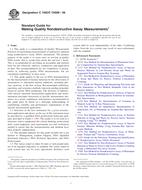Potrebujeme váš súhlas na využitie jednotlivých dát, aby sa vám okrem iného mohli ukazovať informácie týkajúce sa vašich záujmov. Súhlas udelíte kliknutím na tlačidlo „OK“.
ASTM C1553-08
Standard Guide for Drying Behavior of Spent Nuclear Fuel
Automaticky preložený názov:
Štandardné Guide pre vysúšanie Správanie vyhoreného jadrového paliva
NORMA vydaná dňa 1.1.2008
Informácie o norme:
Označenie normy: ASTM C1553-08
Poznámka: NEPLATNÁ
Dátum vydania normy: 1.1.2008
Kód tovaru: NS-11815
Počet strán: 16
Približná hmotnosť: 48 g (0.11 libier)
Krajina: Americká technická norma
Kategória: Technické normy ASTM
Kategórie - podobné normy:
Anotácia textu normy ASTM C1553-08 :
Keywords:
ICS Number Code 27.120.30 (Fissile materials and nuclear fuel technology)
Doplňujúce informácie
| Significance and Use | ||||||||||||||||||||||
|
This guide provides technical information for use by SNF owners to determine the forms of water usually associated with spent nuclear fuel due to corrosion damage of the fuel, cladding and storage materials during irradiation and in storage pools. Drying may be needed to prepare the SNF for sealed dry storage, transportation, and/or permanent disposal at a repository. This guide provides information for: 4.1.1 Evaluating what drying system should be used, 4.1.2 Drying methods, and 4.1.3 Methods to confirm that adequate dryness was achieved. The guide can be used to determine: 4.2.1 Drying technologies that are designed to remove most of the unbound water but will not remove all forms of water. Water remaining on and in commercial and research reactor spent nuclear fuels coming from water basin storage may become an issue when the fuel is sealed in a dry storage system or transport cask. The movement to a dry storage environment typically results in an increase in fuel temperature due to the decay heat. This temperature change could be significant to cause the release of water remaining in a sealed dry package that may result in container pressurization, fuel retrievability issues, and container corrosion. 4.2.2 A methodology for evaluating drying processes that may not readily remove all forms of water that may be retained in pores in fuel cladding, capillaries, sludge, crud, and thin wetted surface films. Drying techniques are even less successful in removing bound water. Removal of bound water will only occur when the specific threshold energy is applied to break the bonds involved and release the water. For spent nuclear fuel this threshold energy may come from the combination of thermal input and ionizing radiation. 4.2.3 How the residual water retained with the SNF, CRUD and sludge inside a sealed package may become available to react with the internal environment, the fuel, and the package materials as a result of extended time at equilibrium dry storage temperatures, or as the direct result of radiolytic decomposition. |
||||||||||||||||||||||
| 1. Scope | ||||||||||||||||||||||
|
1.1 This guide is organized to discuss the three major components of significance in the drying behavior of spent nuclear fuel: evaluating the need for drying, drying spent nuclear fuel, and confirmation of adequate dryness. 1.1.1 The guide addresses drying methods and their limitations in drying spent nuclear fuels that have been in storage at water pools. The guide discusses sources and forms of water that remain in SNF, its container, or both, after the drying process and discusses the importance and potential effects they may have on fuel integrity, and container materials. The effects of residual water are discussed mechanistically as a function of the container thermal and radiological environment to provide guidance on situations that may require extraordinary drying methods, specialized handling, or other treatments. 1.1.2 The basic issue in drying is to determine how dry the SNF must be in order to prevent issues with fuel retrievability, container pressurization, or container corrosion. Adequate dryness may be readily achieved for undamaged commercial fuel but may become a complex issue for any SNF where cladding damage has occurred during fuel irradiation, storage, or both, at the spent fuel pools. Dryness issues may also result from the presence of sludge, crud, and other hydrated compounds connected to the SNF that hold water and resist drying efforts. 1.2 This standard does not purport to address all of the safety concerns, if any, associated with its use. It is the responsibility of the user of this standard to establish appropriate safety and health practices and determine the applicability of regulatory limitations prior to use. |
||||||||||||||||||||||
| 2. Referenced Documents | ||||||||||||||||||||||
|
Podobné normy:
Historická
1.2.2011
Historická
1.6.2009
Historická
1.6.2012
Historická
1.1.2013
Historická
1.1.2014
Historická
1.6.2009



 ASTM C1554-11
ASTM C1554-11 ASTM C1592/C1592M-09..
ASTM C1592/C1592M-09.. ASTM C1625-12
ASTM C1625-12 ASTM C1636-13
ASTM C1636-13 ASTM C1672-07(2014)..
ASTM C1672-07(2014).. ASTM C1682-09
ASTM C1682-09
 Cookies
Cookies
